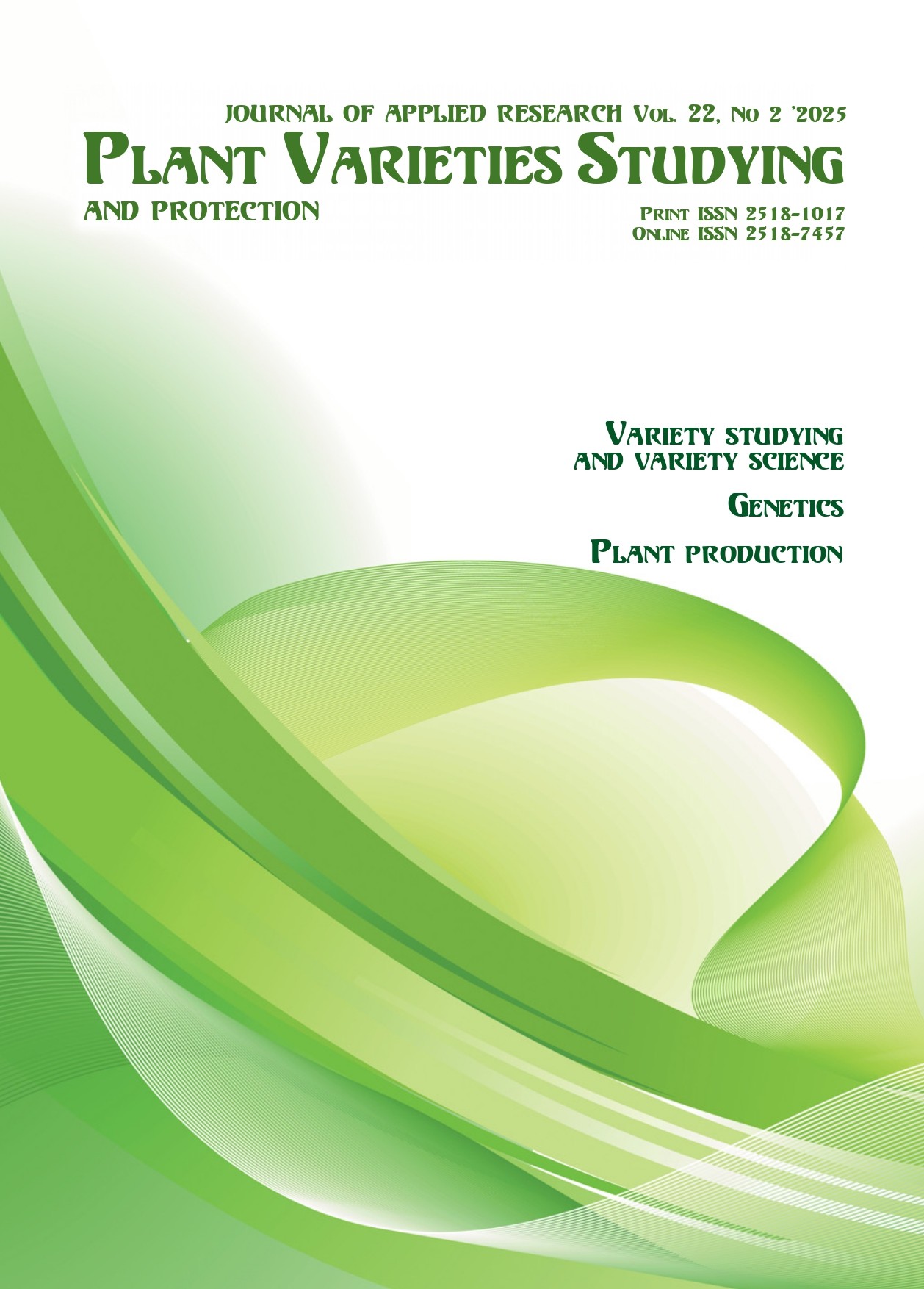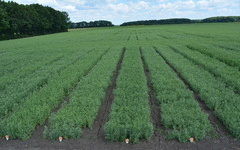Growth characteristics of foreign willow (Salix viminalis L.) varieties on leached chernozems of the Central Forest-Steppe
DOI:
https://doi.org/10.21498/2518-1017.21.2.2025.333455Keywords:
bioenergy, energy willow plantations, height growth, diameter growth, age of biomass harvestingAbstract
Purpose. To analyze the growth characteristics of six varieties of basket willow plantations over eight years of cultivation in the Right-Bank Forest-Steppe of Ukraine. Establish the optimal age for harvesting biomass. Methods. Field, laboratory, analytical and statistical. Results. Biometric studies of eight-year-old shoots from plantations revealed differences in their height, diameter, and weight. The cultivar ‘Inger’ had the highest values: 6.42 m, 3.3 cm, and 1.76 kg, respectively. The values were slightly lower for ‘Tordis’: 6.25 m, 3.1 cm, and 1.67 kg. The heights of the other varieties ranged from 5.90 m (‘Warm-maz’) to 6.13 m (‘Wilhelm’), the diameters ranged from 1.85 cm (‘Gigantea’) to 2.55 cm (‘Marzencinski’), and the dry weights of the shoots ranged from 0.89 kg (‘Gigantea’) to 1.05 kg (‘Marzencinski’). Dry biomass productivity ranged from 9.55 t/ha (‘Gigantea’) to 36.9 t/ha (‘Inger’). A significant decrease in annual height growth was observed in all the studied cultivars: after five years in ‘Tordis’, after four years in ‘Wilhelm’, ‘Inger’, ‘Gigantea’, and ‘Marzencinski’, and after three years in ‘Warm-maz’. A significant decrease in diameter growth was observed after five years in ‘Wilhelm’, after three years in ‘Tordis’, and after four years in the rest. Conclusions. The first harvesting of biomass from the studied plantations should be carried out at the age of four years, and the subsequent harvesting at the age of three or two years.
Downloads
References
Ahmad, M., Ahmed, Z., Majeed, A., & Huang, B. (2021). An environmental impact assessment of economic complexity and energy consumption: Does institutional quality make a difference? Environmental Impact Assessment Review, 89, Article 106603. https://doi.org/10.1016/j.eiar.2021.106603

Adedoyin, F. F., Alola, A. A., & Bekun, F. V. (2020). An assessment of environmental sustainability corridor: The role of economic expansion and research and development in EU countries. Science of The Total Environment, 713, Article 136726. https://doi.org/10.1016/j.scitotenv.2020.136726
 |
| 
Adoption of the Paris agreement. 2015. https://unfccc.int/resource/docs/2015/cop21/eng/l09r01.pdf
Solarin, S. A. (2020). An environmental impact assessment of fossil fuel subsidies in emerging and developing economies. Environmental Impact Assessment Review, 85, Article 106443. https://doi.org/10.1016/j.eiar.2020.106443

State Statistics Service of Ukraine. (2020). Energy balance of Ukraine for 2020. https://www.ukrstat.gov.ua/operativ/operativ2021/energ/En_bal/Bal_2020_ue.xls [In Ukrainian]
Teske, S., & Pregger, T. (2019). Introduction. In Achieving the Paris Climate Agreement Goals (pp. 1–4). Springer International Publishing. https://doi.org/10.1007/978-3-030-05843-2_1

Sinchenko, V. M. (Ed.). (2023). Energy willow: Cultivation and use technology. Tvory. [In Ukrainian]
Neves, A., Godina, R., Azevedo, S. G., & Matias, J. C. O. (2020). A comprehensive review of industrial symbiosis. Journal of Cleaner Production, 247, Article 119113. https://doi.org/10.1016/j.jclepro.2019.119113

Mundaca, L., Ürge-Vorsatz, D., & Wilson, C. (2018). Demand-side approaches for limiting global warming to 1.5 °C. Energy Efficiency, 12(2), 343–362. https://doi.org/10.1007/s12053-018-9722-9

Pittau, F., Lumia, G., Heeren, N., Iannaccone, G., & Habert, G. (2019). Retrofit as a carbon sink: The carbon storage potentials of the EU housing stock. Journal of Cleaner Production, 214, 365–376. https://doi.org/10.1016/j.jclepro.2018.12.304

El Bassam, N. (2012). Handbook of Bioenergy Crops: A Complete Reference to Species, Development and Applications. Earthscan.
Caslin B., Finnan J., McCracken A. (Eds). Willow Varietal Identification Guide. Teagasc.
Pasternak, V. P., & Nazarenko, V. V. (2019). Forest Inventory. Kharkiv National Agrarian University. [In Ukrainian]
Fuchylo, Ya. D., & Levchuk, T. A. (2024). Productivity of the rod-shaped willow depends on varietal characteristics and frequency of biomass harvesting. Bioenergy, 1, 16–18. https://doi.org/10.47414/be.2024.no1.pp16-18
Fuchylo, Ya. D., & Levchuk, T. A. (2024). Productivity of six varieties of basket willow in a three-year cycle of biomass harvesting. Bioenergy, 2, 35–37. https://doi.org/10.47414/be.2024.No2.pp35-37
Sinchenko, V. M. (Ed.). (2018). Methodology for research into energy plantations of willows and poplars. Komprint. [In Ukrainian]
Pollock, A., Grant, K. R., & Schoonmaker, A. (2025). Size Influences on the Survival of Willow Cuttings Under Operational Field Conditions. Ecology and Evolution, 15(1), Article e70835. https://doi.org/10.1002/ece3.70835

Fuchylo, Ya. D., & Sbytna, M. V. (2017). Willows of Ukraine: Biology, ecology, use (2nd ed., rev. and enl.). Komprint. [In Ukrainian]
Salix triandra. (2020). Willows of Northern Europe: A guide to the identification and ecology of a northern keystone plant group. https://willows-of-northern-europe.org/Salix_triandra.html
Borz, S. A., Papandrea, S., Zoli, M., Bacenetti, J., & Proto, A. R. (2025). Willow short rotation coppice. Energy and environmental assessment. Cleaner Environmental Systems, 16, Article 100249. https://doi.org/10.1016/j.cesys.2024.100249

Livingstone, D., Smyth, B. M., Lyons, G., Foley, A. M., Murray, S. T., & Johnston, C. (2022). Life cycle assessment of a short-rotation coppice willow riparian buffer strip for farm nutrient mitigation and renewable energy production. Renewable and Sustainable Energy Reviews, 158, Article 112154. https://doi.org/10.1016/j.rser.2022.112154

Quinn, R. J., Ha, H., Volk, T. A., Brown, T. R., Bick, S., Malmsheimer, R. W., & Fortier, M. P. (2020). Life cycle assessment of forest biomass energy feedstock in the Northeast United States. GCB Bioenergy, 12(9), 728–741. https://doi.org/10.1111/gcbb.12725

Published
How to Cite
Issue
Section
License
Copyright (c) 2025 Ya. D. Fuchylo, T. A. Levchuk

This work is licensed under a Creative Commons Attribution-ShareAlike 4.0 International License.
Starting in 2022, the copyright to the publication remains with the authors
Our journal abides by the CREATIVE COMMONS copyright rights and permissions for open access journals.
Authors, who are published in this journal, agree to the following conditions:
- The authors reserve the right to authorship of the work and pass the first publication right of this work to the journal under the terms of a Creative Commons Attribution License, which allows others to freely distribute the published research with the obligatory reference to the authors of the original work and the first publication of the work in this journal.
- The authors have the right to conclude separate supplement agreements that relate to non-exclusive work distribution in the form in which it has been published by the journal (for example, to upload the work to the online storage of the journal or publish it as part of a monograph), provided that the reference to the first publication of the work in this journal is included.

























 Ukrainian Institute for Plant Varieties Examination
Ukrainian Institute for Plant Varieties Examination  Селекційно-генетичний інститут
Селекційно-генетичний інститут Institute of Plant Physiology and Genetics of the National Academy of Sciences of Ukraine
Institute of Plant Physiology and Genetics of the National Academy of Sciences of Ukraine
 The National Academy of Agrarian Sciences of Ukraine
The National Academy of Agrarian Sciences of Ukraine